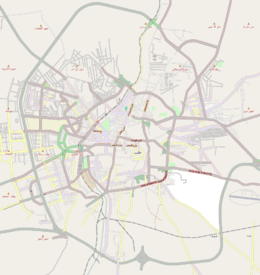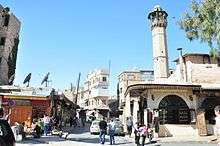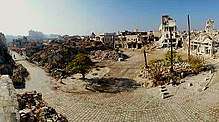Al-Hatab Square
| Al-Hatab Square | |
|---|---|
|
Native name Arabic: ساحة الحطب | |
|
Al-Hatab Square | |
| Location | Aleppo, Syria |
| Coordinates | 36°12′26″N 37°09′25″E / 36.20722°N 37.15694°ECoordinates: 36°12′26″N 37°09′25″E / 36.20722°N 37.15694°E |
| Built | 1420s |
 Location of Al-Hatab Square in Aleppo | |
Al-Hatab Square (Arabic: ساحة الحطب, Sahat al Hatab) is one of the oldest squares in the Syrian city of Aleppo. It is located in the old Jdeydeh Quarter, outside the historic walls of the Ancient City of Aleppo. The square suffered catastrophic damage during the Syrian civil war.
History

In 1400, the Mongol-Turkic leader Tamerlane captured the city of Aleppo from the Mamluks and massacred many of its inhabitants.[1][2] After the withdrawal of the Mongols, the Muslim population returned to Aleppo.[3] In contrast the Christian residents, unable to resettle in their own city quarters, established a new neighbourhood just to the north of the city walls in the early 1420s.[4] This area became known as Aleppo's al-Jdeydeh (Jdeideh) Quarter (for "new district" in Arabic).[5][6]
Al-Hatab Square became the centre of this newly established quarter and was surrounded by many churches, hammams, khans, caravanserais and caeserias.[7][8] Many Christians chose this area as a number of fifteenth century churches had been located there.[9] A number of structures here were built on earlier Byzantine foundations. A mosque (al-Sharaf Mosque), waqf, khan and coffee house were established around the square by the seventeenth century to help service the local inhabitants and visitors.[9] Many Armenians also settled in the area as early as the 1600s to develop the growing silk trade with Persia.[9]
The square and khans quickly became one of the busiest commercial hubs of the city.[10] Many European traders would also come to do business here as many of their local agents and translators lived in this area.[5][11]
The 1850 massacre of Christians and others in Aleppo also originated in and around Al-Hatab Square.[12]
Renovation and Revitalisation
.jpg)
By 2011 Sahat al Hatab square, and the Jdeideh neighbourhood around it, had underdone a revitalisation process.[13] It became home to many boutique hotels housed in historic buildings such as the Zamaria House,[14] museums such as the Beit Ghazaleh and Beit Achiqbash, and number of noted restaurants that celebrated the local cuisine.[15][16]

The square, which had once been previously been built over with trader´s sheds, was rehabilitated as a shared and open public space.[17][18] Its expanse, and the streets around it, went on to foster a vibrant mix of Syrian families and foreign tourists.[19][20]
This civic project, as part of a plan to protect the Old City of Aleppo,[21] began in 1995 came with some controversy regarding land speculation, land use and its impact on existing residents.[22] The project was also a recipient of international award for urban planning and renewal.[17][23]
The square became a popular destination, especially for visitors passing through the narrow alleyways of Aleppo's Old City[24]—it was home to many shops of antiques and handmade jewellery.[25][26]
The famous ful parlor Abu Abdo was also located near the square.[10][27]
Recent Developments

Sahat Al Hatab suffered catastrophic damage during the Syrian civil war that began in Aleppo in 2012.[28][29] A series of huge underground explosions conducted by the armed opposition under the square in April 2015 devastated it along with the surrounding historic buildings.[30][31][32]
Al Hatab Square, and its al-Jdayde (Jdeideh) Quarter, found itself on the front line from the beginning in what became a war of attrition between combatant forces.[33][34]
The area, like much of the old city, remained a closed militarized zone for most of this period and was heavily damaged from fighting.[35] Official damage assessments conducted after the evacuation of rebel forces determined Sahat al Hatab to have been "highly affected" by civil war fighting.[36]
While the Jdayde Hotel along with other buildings surrounding the square were mostly destroyed,[37][38] the craters on it were backfilled and its surface levelled during 2017. In 2018 further remediation work was undertaken in the area.[39]
Sources and further reading
- Bruce Masters (1991) Aleppo the Ottoman Empire's caravan city in Edhem Eldem, Daniel Goffman, and Bruce Masters (1999), "The Ottoman City between East and West: Aleppo, Izmir, and Istanbul." Cambridge: Cambridge University Press, pp. 17–78.
- Jean-Claude David (1990) L'espace des chrétiens à Alep. Ségrégation et mixité, stratégies communautaires (1750-1850) Revue du monde musulman et de la Méditerranée Année 1990 Volume 55 Numéro 1 pp. 150–170
- Masters, Bruce (February 1990). "The 1850 Events in Aleppo: An Aftershock of Syria's Incorporation into the Capitalist World System". International Journal of Middle East Studies. Cambridge University Press. 22: 3–20. JSTOR 164379.
- Burns, Ross, Aleppo: A History. London : Routledge, Taylor & Francis Group, 2017.p. 197, 231-2.
- Mansel, Philip, Aleppo: The Rise and Fall of Syria’s Great Merchant City. London: I.B. Tauris, 2016.
- MİROĞLU, EBRU ARAS (2005). "THE TRANSFORMATION OF URBAN SPACE AT THE CONJUNCTION OF THE OLD AND NEW DISTRICTS: THE CITY OF ALEPPO" MIDDLE EAST TECHNICAL UNIVERSITY. Thesis: pp. 60–5.
- Francesco Lanyafame and Eduardo Rojas(Eds)(2011) City Development: Experiences in the preservation of ten world heritage sites. Washington DC: Inter-American Development Bank. Publication Code IDB-MG-121, 377pp.
- Bernadette, Bairs-Zars (2010) Developing heritage: activist decision-makers and reproducing narratives in the Old City of Aleppo, Syria. Thesis Massachusetts Institute of Technology, Dept. of Urban Studies and Planning.
Gallery
 Antiques shop at the square
Antiques shop at the square View from the Al Hatab square
View from the Al Hatab square Bread being dried at Al Hatab Square in 2010
Bread being dried at Al Hatab Square in 2010 Sahat Al Hatab as seen in January 2017
Sahat Al Hatab as seen in January 2017
See also
References
- ↑ Gillespie, Alexander (2011-10-07). A History of the Laws of War: Volume 3: The Customs and Laws of War with Regards to Arms Control. Bloomsbury Publishing. p. 129. ISBN 9781847318411.
- ↑ Runciman, Steven (1987-12-03). A History of the Crusades. CUP Archive. p. 463. ISBN 9780521347716.
- ↑ "Battle of Aleppo - Everything2.com". everything2.com. Retrieved 2016-12-09.
- ↑
- 1 2 Burns, Ross (2016-08-25). Aleppo: A History. Routledge. p. 197. ISBN 9781134844081.
- ↑ David, Jean-Claude. "L'espace des chrétiens à Alep. Ségrégation et mixité, stratégies communautaires (1750-1850)". Revue du monde musulman et de la Méditerranée (in French). 55 (1): 150–170. doi:10.3406/remmm.1990.2340.
- ↑ Caeserias were small marketplace (smaller than khans) and were also craftsmen's workshops.
- ↑ Eldem, Edhem; Goffman, Daniel; Masters, Bruce (1999-11-11). The Ottoman City Between East and West: Aleppo, Izmir, and Istanbul. Cambridge University Press. pp. 39–40. ISBN 9780521643047.
- 1 2 3 Burns, Ross (2016-08-25). Aleppo: A History. Routledge. pp. 179, 231–2. ISBN 9781134844081.
- 1 2 Darke, Diana (2010-01-01). Syria. Bradt Travel Guides. ISBN 9781841623146.
- ↑ "Christians in Aleppo: Rumblings beneath the Surface - Qantara.de". Qantara.de - Dialogue with the Islamic World. Retrieved 2017-03-23.
- ↑ Commins, David; Lesch, David W. (2013-12-05). Historical Dictionary of Syria. Scarecrow Press. ISBN 9780810879669.
- ↑ Ourousseff, Nicolai (26 December 2010). "Preserving Heritage, and the Fabric of Life, in Syria". The New York Times. Retrieved 27 December 2016.
- ↑ Atlioglu, Dr Yasin (2012-09-30). "ORIENT: Aleppo Burns – Dar Zamaria, Sisi House and much of Souq reported Burned- Syria Comment". ORIENT. Retrieved 2017-01-01.
- ↑ Booth, Marilyn (2010-01-01). Harem Histories: Envisioning Places and Living Spaces. Duke University Press. pp. 217–8. ISBN 0822348691.
- ↑ Darke, Diana (2010-01-01). Syria. Bradt Travel Guides. p. 185. ISBN 9781841623146.
- 1 2 Booth, Marilyn (2010-01-01). Harem Histories: Envisioning Places and Living Spaces. Duke University Press. p. 218. ISBN 0822348691.
- ↑ Jaber, Sylvia (2013). "Dissertation -- Urban streets : towards sustainable mobility in Arabic cities". Universität Stuttgart 01 Fakultät Architektur und Stadtplanung: 318 – via Online Publikationen der Universität Stuttgart.
- ↑ "Weblog of a Syrian Diplomat in China". Weblog of a Syrian Diplomat in China. Retrieved 2017-03-26.
- ↑ Haddad, Rema George (2009). Changes in the nature of governance of public spaces in the historic city centre. ROS Theses Repository: Dissertation Heriot-Watt University School of the Built Environment. p. 140 – via http://www.ros.hw.ac.uk/handle/10399/2303.
- ↑ Cobb, Elvan (2010). "Cultural Heritage in Conflict: World Heritage Cities of the Middle East". repository.upenn.edu. University of Pennsylvania Scholarly Commons. pp. 56–64. Retrieved 1 Jan 2016.
- ↑ Bairs-Zars (2010), Bernadette (2010). Developing heritage: activist decision-makers and reproducing narratives in the Old City of Aleppo, Syria. https://dspace.mit.edu/handle/1721.1/59713: Thesis Massachusetts Institute of Technology, Dept. of Urban Studies and Planning.
- ↑ "Aleppo — Joan Busquets | Harvard University Press". www.hup.harvard.edu. Retrieved 2017-01-01.
- ↑ Ouroussoff, Nicolai (2010-12-26). "Aleppo, Syria, Preserves the Past by Enhancing the Present". The New York Times. ISSN 0362-4331. Retrieved 2017-03-26.
- ↑ Ouroussoff, Nicolai (2010-12-26). "Aleppo, Syria, Preserves the Past by Enhancing the Present". The New York Times. ISSN 0362-4331. Retrieved 2016-12-09.
- ↑ Simmons, By Gail. "Aleppo, Syria: a cultural guide". Telegraph.co.uk. Retrieved 2017-01-01.
- ↑ Amudi83 (2010-09-18), Foul shop in Aleppo (Syria) the best one in the city, retrieved 2017-01-01
- ↑ "Syria: Christians take up arms for first time". Telegraph.co.uk. Retrieved 2016-12-09.
- ↑ "The Antiquities Directorate of Aleppo inspected the damage at both Beit Ghazaleh & Beit Ashiqbash20/08/2016 - عدد القراءات : 1116". www.dgam.gov.sy. Retrieved 2016-12-09.
- ↑ jdeideh jdayde (2015-04-30), Al Jdeideh Jdayde April 2015 Sahet Al-Hatab Square Aleppo, retrieved 2016-12-09
- ↑ "Damage Assessment of Aleppo, Aleppo Governorate, Syria (10 Jul 2015)". ReliefWeb. 2015-07-22. Retrieved 2016-12-09.
- ↑ "ASOR Cultural Heritage Initiatives Weekly Report 38 (April 27, 2015)". ASOR Cultural Heritage Initiatives. 2015-05-28. Retrieved 2017-01-03.
- ↑ "Aleppo's famed Old City left 'unrecognisable' by war". Al-Monitor. 2016-12-30. Retrieved 2016-12-30.
- ↑ "Aleppo After the Fall, New York Times Magazine". Retrieved 2017-05-27.
- ↑ "Aleppo's famed Old City left 'unrecognisable' by war". Al-Monitor. 2017-01-01. Retrieved 2017-01-01.
- ↑ Ministry of Culture Directorate General of Antiquities & Museums (2017) STATE PARTY REPORT On The State of Conservation of The Syrian Cultural Heritage Sites (Syrian Arab Republic), 1 February 2017, available on http://whc.unesco.org/document/155953
- ↑ UNOSAT (December 20, 2016). "SYRIA Aleppo City / Jebel Saman District / Aleppo Province Imagery analysis:18 September 2016" (PDF). UN. Retrieved Jan 5, 2017.
- ↑ "Aleppo's famed Old City 'unrecognizable'". The Daily Star Newspaper - Lebanon. 2016-12-14. Retrieved 2017-04-27.
- ↑ "Restoration work currently undergoing at Qalat al Sharif and Sahat al Hatab". Twitter. Retrieved 2018-08-26.